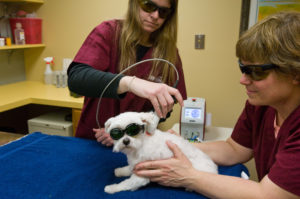Laser Therapy for Pets
For many years, world-class athletes and thoroughbred race horses have benefitted from laser therapy treatments. Fortunately, this technology is now available for pets.
Infrared laser light from therapy lasers harmlessly penetrates deep into tissues where it is absorbed in the cells, and this energy is converted into chemical, not thermal, energy. In athletic environments, therapy lasers are primarily used to reduce swelling, reduce pain, and speed the healing process. These mechanisms allow veterinarians to successfully treat a wide range of conditions non-invasively and without drugs.
Laser therapy speeds healing, so veterinarians routinely treat injuries with the laser, as well as treating patients immediately after surgery so incisions heal more quickly. Studies indicate that laser-treated wounds heal in a third to a half faster than the time required in normal healing. A single laser treatment is usually all that is required for post-surgical patients to reduce swelling and to speed healing. Skin wounds, abrasions, bite injuries, dermatitis, and burns all respond well to laser therapy.
Acute conditions may require more than a single treatment, but also respond well to laser therapy. Because laser therapy laser can be administered without touching the painful area, veterinarians are able to provide immediate pain relief and edema control to very sensitive tissues.
Laser therapy also reduces inflammation by increasing vasodilation, activating the lymphatic drainage system, and reducing pro-inflammatory mediators. As a result, inflammation, erythema, bruising, and edema are all reduced when treated with laser. This is especially important for conditions where anti-inflammatory medications are risky for the patient because of the patient’s age, liver health, or species. Laser therapy is a drug-free treatment modality that can often replace or enhance other treatment plans recommended by your veterinarian.
A benefit of the more modern, higher-powered therapeutic lasers, like the Companion Therapy Laser, is that adequate dosages of laser energy, or photons, can be painlessly and efficiently delivered to deeper tissues. This is a huge benefit in treating chronic conditions such as arthritis, hip dysplasia, back disease or injury, and degenerative joint diseases. Geriatric patients often suffer from one or more of these painful problems, as well the aches and pains that come naturally with aging. There thousands of reports of pets who were lame an inactive who return to normal, or almost normal function after laser therapy. More chronic and more severe cases may require multiple treatment sessions to fully benefit.
Veterinarians are also using therapeutic lasers to stimulate muscle and acupuncture points painlessly and without needles.







One comment